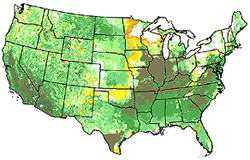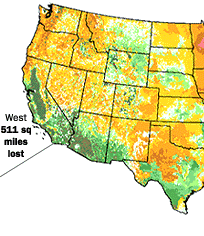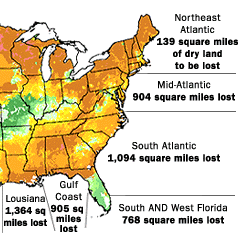A profoundly altered landscape
 Impact on New England
Impact on New England
The increase in global temperature is expected to cause the sea level to rise. See how Cape Cod and the islands could lose significant amounts of land. [ Maps ]
|
|
While most scientists agree
on the reality of global warming, the biggest uncertainty involves how fast the changes could occur.
If rapid, our descendants may remember the dawn of the 21st century as either a time when potential
climatic disaster was averted, because people adjusted their energy choices, or as a time when
the chance to prevent global climate change was lost forever.
2050 or later . . .
Vegetation changes
Unless emissions of greenhouse gases from the burning of
fossil fuels are sharply curtailed, the latest computer models of climate change show that by 2100 or so,
the United States could be a hotter and wetter place.
|
|
Vegetation increases and decreases in 2050:
|
As a result, most of the country could face a dramatic
decrease in vegetation, as shown in the large map below, produced by Ron Neilson of Oregon State University.
Brown areas reflect a decrease of 50 percent or more in the quantity of growing plants in a given area,
compared with the present. As shown in the smaller map, above, some areas may first experience an
increase in vegetation in the middle of the century, followed by a sharp decline.
2100 or later . . .
Rising tides (and vegetation changes)
Scenarios vary widely. However, large amounts of dry land could be lost by 2100 with a 20-inch
rise in sea level, considered likely by that date. This assumes that no protective meas- ures such
as sea walls are created.
Climate at the end of the 21st century
|
Rainfall patterns may increase in some
parts of the world and decrease in others, but most climate models predict that virtually all of the United States will see
wetter conditions. While temperatures are expected to rise almost everywhere,
some places and some seasons will experience greater increases than others.
|
|
Rainfall

Temperature

|
By David L. Chandler, Globe Staff
|



![]()
![]()












